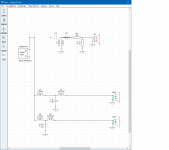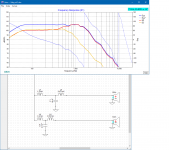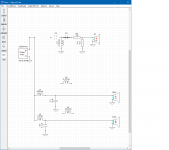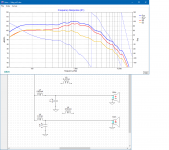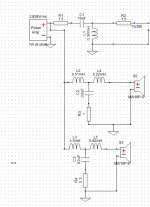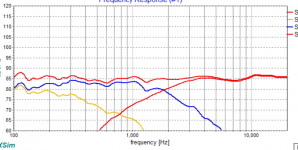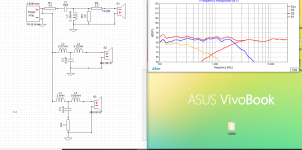Well.......... 'edge', 'sibilance', 'pierce' and especially 'definition', that originally defined 'high fidelity' are all in the ~3.5-11.2 kHz BW, right where this driver 'shouts' its breakup modes, so if you're like me and overly sensitive to this BW, then either using a much lower XO point and/or doping or some other form of damping will be required wherever on the cone this is occurring.
GM
GM
I did recently just finish a pair of booksshelves using the mw16p-8 with d2608/913000 tweeter and must say it is an excellent woofer. I simulated your crossover with my woofer measurements (which included baffle step) and am sorry to say it seems your crossover is way out. I think you will do better with 3rd order (electrical on the woofers. Here is a woofer section I just made up using my woofer measurements.
Attachments
Here is with your original woofer crossover. The lower woofer (baffle step filler) is way to extended. which adds too much in the total woofer 500-2000Hz range. Also I think it is best to use a lower crossover to tweeter. I used 2000Hz crossover. This gets rid of any woofer break up issues. Your tweeter should be able to handle that crossover point without problems.
Attachments
Hi Jim, the Satori MW16P-8 is a low distortion driver across the mid range of frequencies, particularly low in the 3rd harmonic which should present itself as clear and clean.
Satori MW16P-8 | HiFiCompass
Satori TW29R | HiFiCompass
By the way what's the baffle width of your enclosure ? You may be getting a diffraction peak corresponding with a resonant peak in the response ?
C.M
11.5 inch, yes it does come across as very clear and also very dynamic
I did recently just finish a pair of booksshelves using the mw16p-8 with d2608/913000 tweeter and must say it is an excellent woofer. I simulated your crossover with my woofer measurements (which included baffle step) and am sorry to say it seems your crossover is way out. I think you will do better with 3rd order (electrical on the woofers. Here is a woofer section I just made up using my woofer measurements.
Totally agree that a 3rd order may be a potential solution. BTW, I have tried many different XO points so that XO you are referring to is an older version. I'll try to post my current version later.
It will depend on how sensitive you are since some of what may be your harshness isn't attenuated all that much, but hope it works for you.
GM
GM
Ok so I ran the Sim again and I am hopeful this should address the issue. Thoughts?
Crossing over at around 1900 herz is the way to go especially with second order and this woofer. If you cross over at 3000 hz you have to also contend with beaming and the second order woofer will run into harshness after what 5000 hz? Depending on how you decide to put your speakers i see in your last crossover you don't have a 3-6 db gain below 300 herz where you go from half space to full space. So, unless you have a very large baffle you will be pushing your midrange harder ( Base sounds anemic) and that will contribute to harshness. Also, you need to determine the width of your baffle and do the bbc dip where your tweeter and woofer crossover frequencies (about 1-2 db baffle increase diffraction). Having an increase in 2 db there will cause listener fatigue. Hope this helps.
jimbones: I have made several designs with MW16. Your crossover sim from #27 looks quite good. I have several points:
1. From my experience, you might need to decrease whole tweeter by 1-2dB.
2. You might need to decrease area around 3kHz. Whole set of off-axis responses would be helpful to assess power response.
3. FRs have too much of smoothing, this might cover some issue (diffraction,...).
1. From my experience, you might need to decrease whole tweeter by 1-2dB.
2. You might need to decrease area around 3kHz. Whole set of off-axis responses would be helpful to assess power response.
3. FRs have too much of smoothing, this might cover some issue (diffraction,...).
It will depend on how sensitive you are since some of what may be your harshness isn't attenuated all that much, but hope it works for you.
GM
GM could you elaborate so I can make required changes?
The on-axis bump centered around 4kHz is not the best thing imo. A typical dome tweeter has a very wide dispersion in that region, so a power response peak can appear easily.
With the lower crossover point, the mid has less beaming, but that 4Khz bump gets worse.
A measurement from the listening spot would be helpful.
With the lower crossover point, the mid has less beaming, but that 4Khz bump gets worse.
A measurement from the listening spot would be helpful.
The on-axis bump centered around 4kHz is not the best thing imo. A typical dome tweeter has a very wide dispersion in that region, so a power response peak can appear easily.
With the lower crossover point, the mid has less beaming, but that 4Khz bump gets worse.
A measurement from the listening spot would be helpful.
Thanks for pointing that out. I think that will be better addressed by the tweeter XO section. I'll try more options and post.
GM could you elaborate so I can make required changes?
Well, human hearing being what it is, to attenuate something in our peak hearing acuity BW it needs to be > -25 dB, so at ~ 3.5 kHz with a 4th order XO as close enough = < 1.75 kHz point, 0.875 kHz/2nd order, too low for the tweeter or too steep for a 4th order passive for most folk's budget.
I'm a believer in acoustic solutions to acoustic problems, hence my doping/whatever way to deal with it, but as wiseoldtech noted right off, the digital/traditional way is to shelve down the offensive BW with one or more 'steps' with the implication of alternately notching it out with a RL or RLC frequency shaping filter [AKA CD horn EQ, so we're talking ~100 yr old tech here] and if it still sounds a bit harsh, then add a 2nd step or broader BW filter, allowing max tweeter XO point/slope flexibility to optimize it as part of a polar/power response system, the main difference between studio monitor/prosound speaker performance and pretty much everything else.
Re Lpads, adjustable is fine for quickly dialing in a response, but recommend replacing with a proper filter for fine tuning ['voicing'].
GM
Member
Joined 2009
Paid Member
I've tried various cone treatments but none of them have 'cured' an irritating driver. The one thing that I did find worth trying was to smear some silicone around the backside rim of the cone, about 1cm high strip just where the cone meets the surround - damps the edge modes. But generally, based on my experience with Fostex, Mark Audio, Audio Nirvana and at least one other - the answer has always been to replace the driver. Admittedly this was all with respect to single full range drivers. So if it turns out that your problem is not a poor choice of XO allowing woofer/mid cone break-up to escape into the room it may just be better to look for another driver or drivers altogether.
Yes, but 3 kHz was ~ -20 dB in the earlier sim, now it's only ~ -12-13 dB because you raised the XO point + added some shelving, when it needed to go lower and maybe some shelving higher up to get it > -25 dB, but the tweeter can't handle it.
GM
GM
I personally haven't tried like this before, but the slopes are now very asymmetrical, and the phase tracking looks not so good too because the frequency reinforcement is only around 3dB at xo point and the overlap is very small. But some say that phase is not important, i don't know.
It would be nice to see off-axis measurements.
I would definitely try to target a 4th order acoustic slope with a 3rd order crossover to the tweeter.
It would be nice to see off-axis measurements.
I would definitely try to target a 4th order acoustic slope with a 3rd order crossover to the tweeter.
- Status
- Not open for further replies.
- Home
- Loudspeakers
- Multi-Way
- Assistance with cause of Harshness
